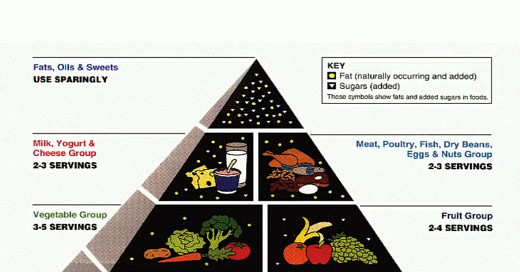Introduction
“Big Agriculture In Government” (BIG) is an acronym I made to describe what happens when you eat their diet. BIG Bullshit below:
For much of my life, I was taught that the secret to good health was simply eating the right foods and believing nature had our backs always gave me a sense of comfort. Thanks to the indoctrinated education system funded by Uncle Sam’s USDA and backed by his “Big Agriculture” connections, I was easily convinced there was no need to think twice about supplements—our food would take care of all the essential vitamins and minerals we needed. Turns out, I was wrong—more often than I care to admit—but this time, I was really off the mark - and I hate when that happens.
At some point Nature as in natural, as in no drugs, chemicals, processing, etc. was taken out of our foods and replaced with chemistry experiments - brought to you by BIG.
The image below is a glimpse of a small sample of the micronutrients and alkaloids I now use. I’ll get into more details in future blog posts, but here’s a sneak peek.
I had always followed the Food Pyramid, believing it would lead to a healthy and vibrant life. Who wouldn’t want to eat 6-11 servings of bread, cereal, rice, pasta, and 2-4 servings of fruit distributed over 6 meals a day? Deep down, I knew it couldn’t be as simple as they made it seem. I trusted Uncle Sam, but looking back now, I suspect he would have a hard time looking us in the eyes. BIG was getting us big, and bigger, and unhealthy.
Ignored Warning Signs Everywhere
During my peak training years, I frequently traveled between the East and West Coasts for work to see clients, deliver speeches, and attend executive briefings. The trips were memorable in the best way. For many, it would have been exhausting, but I thrived on the challenge. While in San Diego, I’d run through Torrey Pines State Natural Reserve (even if I never get to see it again, it will remain my favorite, and a must-see for anyone).
My work and sometimes training partner, Dr. Freddie, would join me at the start of the run, but then head to the beach to take in the stunning sunbathing scenery. Occasionally, I’d swim in the Pacific (though the water was freezing!) but spent most of my swimming training at a local pool. In Silicon Valley, I’d run the Guadalupe River Trail, the Embarcadero, or across the Golden Gate bridge viewing Treasure Island and turning around in the town of Sausalito. After my morning fitness routine, I was ready to take on the day and would head to the Marriot concierge club for a breakfast buffet. All was good until I finished my so called healthy breakfast, a sudden shift swept over me.
I Went into a Coma Faster and Harder than a Brock Lesnar Punch
My breakfast consisted of oatmeal, fruit, and salmon. No junk—got to listen to BIG and good old Dr. Keys (creator of the food pyramid), right? Eggs? Bad for cholesterol was a lecture I received from friends, family, coworkers, and doctors. I kept hearing that just eat the damn egg whites - what are you stupid or something, let me say it slowly so you can understand! And beef should be reserved for dinner or, at best, a rare lunch. Lean beef, of course, and only a couple of times a week. Don’t be gluten, portions only the size of your palm.Give the fat to the dog, because you are what you eat.
The strangest thing happened every time I finished BIG’s breakfast: I’d be hit with an overwhelming urge to nap. I’m talking full-on coma-level sleep when the only thing that wakes you up is your own snoring.
Of course, I tried changing things up, no workouts on presentation days. That didn’t help. So, I thought maybe it was the sugar in the fruit, so I cut that out the fruit to the same result. Maybe it was the artificial sweetener in the oatmeal? Not likely, and what was I thinking adding artificial sweetener to my breakfast?
I may have looked fit, and yes, my external body was fit, but I wasn’t even close to being fit on the inside. I did not test for sugar levels or how my body handled sugar. Looking back, I believe I did not process sugar effectively because I was in a constant state of carbohydrate overload in order to fuel my workouts. I am certain I was insulin resistant. Okay, so what the heck is insulin resistance, and why do I care? With no background in the medical field, in a moment I will describe “Sugar Levels” for Dummies that even I can understand. But first I need you to do me a favor!
Action Plan and Case Study: Get Yourself to a Doctor
Do you get sleepy after a carbohydrate meal? No matter how hard you exercise do you still retain too much body fat? Really, you are not going to admit it? I know many of us do not like to visit, or trust, doctors, (think BIG) but this is something to reconsider. Do not wait longer than needed as conditions can deteriorate with time and the longer you wait the faster conditions can accelerate.
In the United States, 40% of adults aged 18 to 44 have insulin resistance. Yes, that is you young folks. This condition affects many people before they develop type 2 diabetes or prediabetes. Although known cases of diabetes date back to the Egyptians, it is an epidemic in the United States and spreading throughout the world. Insulin resistance is the primary cause of type 2 diabetes and prediabetes, which increases the risk of heart attack, stroke, cardiac death, and major depressive disorder.
As you embark on your health plan, my hope is that you do the following:
Go see your doctor and get an overall health check.
Find a medical resource that can help with overall blood work
Since this blog is about sugar and insulin resistance, a precursor to type 2 diabetes, find a medical resource that can do a blood test that includes a fasting plasma glucose (FPG) test, A1C tests, or any appropriate test as deemed appropriate to determined by medical industry.
Understanding Sugar and Its Effects for Dummies
I’ll break this down in simple terms because I’m right there with you. I needed to understand this myself. So, let’s talk about sugar.
Our bodies are amazing. When we eat, our digestive system breaks down food into three main components: sugar (glucose), protein (amino acids), and fat (fatty acids). This is the stuff you see on food labels. I remember being taught in school that eating fat makes you fat, protein builds muscle, and carbs give you energy. But it’s more complicated than that, and I’ll explain it later.
When we digest food, it gets broken down into these simpler nutrients and enters the bloodstream. You might say, “But I’m not eating sugar. I’m just eating bread, pasta, rice, fruit, and 'smart' snacks.” I think BIG burned those books. Well, all those carbohydrates turn into sugar in your bloodstream.
I know this is a simplified description, but here’s the deal: When there’s sugar in the blood, your body releases insulin to move that sugar into your cells for energy. The more sugar (or carbs) you eat, the more insulin your body has to produce. But here’s the problem: Over time, your cells become less responsive to insulin. That’s when things go haywire, and your body ends up storing the excess sugar as fat. Too much sugar can overload the liver, causing fatty liver disease, diabetes, and even increasing the risk of heart disease. Yes, BIG makes you big and dependent.
What happens with insulin resistance?
Insulin resistance is when your cells stop responding to insulin properly. This leads to high blood sugar levels, which can eventually result in prediabetes or type 2 diabetes. It also contributes to fatigue after meals because your body struggles to use insulin effectively.
Insulin resistance can lead to serious health problems like:
Type 2 diabetes
Heart disease
Liver disease (including nonalcoholic fatty liver disease)
Kidney disease
Cancer
Autoimmune disorders
Depression and anxiety
Insulin resistance can be treated through - find a good doctor
Weight loss: Excess weight can contribute to insulin resistance. Losing even a small amount of weight can improve insulin sensitivity.
Physical activity: Regular exercise helps muscles use glucose for energy, reducing insulin resistance.
Dietary changes: A balanced diet low in processed foods, sugary drinks, and unhealthy fats can improve insulin sensitivity. Focus on consuming whole grains, fruits, vegetables, and lean protein, and in worst case scenarios medication.
Unaware of the Impact: My Body was Giving me the Solution the Entire Time
One morning, after a night of too much wine and song, I skipped both breakfast and lunch to head straight into meetings. Surprisingly, I felt great. My mind was sharp, I had increased focus, and I felt energized. But how could that be? I was supposed to feel drained because I hadn’t eaten. I think BIG was pissed - it is unheard that a person miss a feeding – you must strap on your BOPP bag (biaxially-oriented polypropylene bag) and eat even if you are not hungry! That’s when I realized—without even knowing it until I wrote this blog—I had stumbled upon intermittent fasting - the anti-BIG solution.
Skipping meals on important workdays became a regular habit, and the mental clarity and energy were undeniable. Little did I know that would set me on the path of knowledge to better health. Fasting has played a pivotal role in my recovery over the past year, and I’ll share more about my journey with fasting in future posts.
Summary:
I was raised to believe that simply eating the “right” foods from the Food Pyramid would ensure good health. I should have seen BIG coming with my experiences in fatigue and weight gain led me to uncover insulin resistance as the true culprit. This condition, where the body struggles to process sugar, caused my fatigue and posed long-term health risks. The solution? Take action. Get a comprehensive blood test, understand how your body processes sugar, and take steps to address insulin resistance. For me, intermittent fasting has been a game-changer. It was my body’s way of telling me what it needed all along.







Looking forward to hearing more about fasting and eating habits. I love exercise but cooking and eating…total time suck. And body killer apparently.
Eating less gives you more energy - sounds crazy but it’s so true!